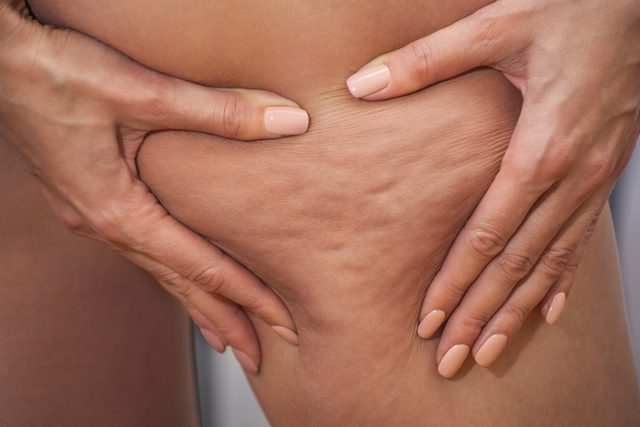Why Is Cellulite So Dang Hard to Get Rid of?
Updated: Apr. 29, 2020
Even after you lose weight, those stubborn lumps never seem to smooth out. What gives?
 If you’ve been frustrated by cottage cheese thighs, you’re not alone. Up to 98 percent of women have cellulite, according to the Journal of Cosmetic and Laser Therapy. No matter how many squats you do or desserts you skip, it’s nearly impossible to smooth out those bulges completely.
If you’ve been frustrated by cottage cheese thighs, you’re not alone. Up to 98 percent of women have cellulite, according to the Journal of Cosmetic and Laser Therapy. No matter how many squats you do or desserts you skip, it’s nearly impossible to smooth out those bulges completely.
The dimpling and orange peel-appearance is caused by fat that collects in pockets just below the surface of the skin, according to the U.S. National Library of Medicine. It typically forms around the hips, thighs, and rear.
A web of connective tissue holds your skin and fat together. Because the tissue isn’t a solid sheet, fat can poke through the empty spaces between walls, says Misbah Khan, MD, founder of M Khan Dermatology and Cosmetic Surgery, and clinical assistant professor of dermatology at Weill Cornell Medical College.
Everyone has layers of fat under the skin, so even if you’re not overweight, some fat is bound to show up as cellulite.
Cellulite in women vs. men
Cellulite is so common in women that it’s “almost considered a secondary sex characteristic,” says Anthony Rossi, MD, dermatologic surgeon at Memorial Sloan Kettering Cancer Center and assistant professor of dermatology at Weill Cornell Medical College. Thank body structure and hormones for giving women more cellulite than men. While almost every woman gets cellulite, only 10 percent of men typically deal with it. Men have a tight mesh of tissue that is more likely to keep fat from pushing through to the surface. Women, however, have fewer bands of connective tissue, says Dr. Khan. “If a woman has three bands of connections, a man would have ten,” she says.
Plus, women’s tissues run in a mostly vertical position, while men’s bands are tighter because they crisscross at a 45-degree angle, says Dr. Khan. Women already hold more fat in their pelvic areas to make pregnancies easier, and that looser net of tissue means more spaces where fat can poke through.
Hormones play a role, too. Though the biology isn’t totally clear, fat cells respond differently to estrogen and testosterone, leaving women more prone to cellulite. “We don’t know if the male hormone prevents it or if the female hormone causes it,” says Dr. Khan.

Looking for cellulite solutions
Weight loss can reduce the appearance of cellulite, but it probably won’t get rid of every dent. Sure you’ll have less fat, but the connective tissues will still be there, says Dr. Rossi. “Weight loss alone won’t get rid of cellulite necessarily,” he says. “If you don’t address those tetherings, you won’t break up what’s bounding the skin and creating the depressions.”
Don’t waste your time with cellulite-bashing creams you see in drugstores either. Their claims to draw out moisture aren’t as effective as they seem, says Dr. Rossi. And other topical treatments might moisturize dry, wrinkly skin so it looks better, but they aren’t actually combating cellulite, says Dr. Khan. (It’s still important to moisturize your skin, though, even if it’s not a cure for cellulite.)
You might even want to look to your diet for foods that could make the appearance of cellulite better or worse.
But if you’re dead set on getting rid of that cottage cheese look, you’ll probably need to visit a dermatologist. A skin doc can use a laser or needle to snip away the tissue, leaving the area smoother, says Dr. Rossi. Several nonsurgical options such as Radiofrequency and Subcision which can help. Before you go, read these 9 things dermatologists wish women knew about cellulite.
As long as you’re at a healthy weight, cellulite is harmless and nearly every woman you know has it too. “It can happen across the board, no matter how skinny you are,” says Dr. Khan.
Now that you know the facts, check out these cellulite myths.
















